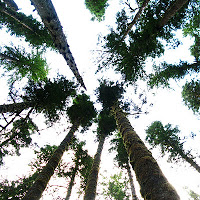Have you ever seen one of those pictures, when you look at it straight on the image is of a beautiful woman and when you stare at it another way you see a haggard old woman’s face? There’s a saying out there somewhere about perspective, that the world is all in how you look at it. Usually we walk around our streets and trails on two feet taking in images from one perspective. However, it is quite possible that if we take the time to look upside down or sideways we might notice a totally different world.
Applying the idea of perspective to outdoor learning programs can add an extra exploratory element to the student’s experience. Consider a tree. When we teach kids about trees, we usually mention the layers of the tree and photosynthesis. We might even have our students draw trees or read a story about a tree. Can we go even further? How many ways can we really experience a tree? There’s a huge difference between looking at a tree and experiencing a tree. Does a tree look any different if when we lie on our backs at its base and stare up into its branches? Does this perspective better allow students to understand the canopy by taking part in its shade and feeling the mottled sunlight stream down through the branches? Not only that but the trunk of the tree soars high above us and takes on extra dimension when we look at it this way.
 How about size? How many ways can we help our students to experience the size of a tree? One way would be to form a chain of students hugging the tree and see how many students fit the circumference of the tree. This tree is three students around and this tree is five students around! Then we can have students do a finger count of different trees in one area of forest, walking around the tree and counting how many widths of a finger the tree is or how many shoes the base is walking heel to heel. Then, perhaps we can move to a different ecosystem zone, like a Riparian area near water, where trees might be bigger, and compare.
How about size? How many ways can we help our students to experience the size of a tree? One way would be to form a chain of students hugging the tree and see how many students fit the circumference of the tree. This tree is three students around and this tree is five students around! Then we can have students do a finger count of different trees in one area of forest, walking around the tree and counting how many widths of a finger the tree is or how many shoes the base is walking heel to heel. Then, perhaps we can move to a different ecosystem zone, like a Riparian area near water, where trees might be bigger, and compare.
Remember when you were young and you looked up at the clouds with your friends making different shapes and characters in the sky. Think back to that experience, maybe at the time you didn’t have a naturalist around you to tell you what kinds of clouds you were looking at but you were gaining an appreciation for that sky and the grass you were lying on and the sun shining down on your face. So when you’re walking around out there, have students lie down on their backs and bellies, crawl around on their hands and knees. Get students to shake hands through cracked boulders and exposed tree roots. These types of educational experiences do more than teach; they form a relationship. As outdoor educators we have the opportunity to take these kinds of experiences and direct them toward both appreciation and learning of the natural world. There is benefit in sitting beside a stream with eyes closed. Besides the peace it gives a child, it is a jumping off point to talk about where that stream is going and how it fits in to their lives.
I was introduced to this type of teaching perspective at an AEOE conference by Outdoor Education leader Steve Van Sandt, member of the popular Banana Slug String Band. Their website, www.bananaslugstringband.com is a great resource of awesome science themed songs.


Comments are closed.